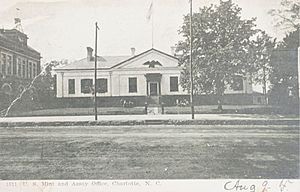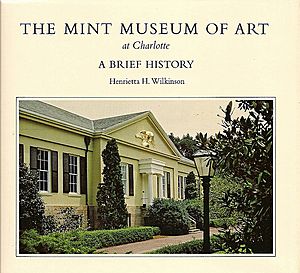Charlotte Mint facts for kids
The Charlotte Mint was the very first branch of the United States Mint. It was built in Charlotte, North Carolina. This special mint was created to make coins only from gold.
Contents
Why Was the Charlotte Mint Built?
The first time gold was officially found in the United States was in North Carolina. Soon, the Reed Gold Mine became the country's first gold mine.
But there was a problem! There was no place nearby to turn the gold into coins. Miners had to send their gold all the way to Philadelphia to be melted and made into money. This trip was hard, slow, costly, and even dangerous.
Because of these problems, some people in the Charlotte area started making their own gold coins. But this also had issues. It was tough to weigh the gold correctly or know how pure it was.
In 1831, merchants and miners in North Carolina asked the United States Congress for a local mint. They wanted to make it safer and easier to turn gold into money. Congress didn't reply for three years. Then, the U.S. Treasury realized North Carolina really needed a federal mint.
On March 3, 1835, Congress voted to create several new mints. One of these was for Charlotte, North Carolina. It would make only gold coins. Congress set aside $50,000 to buy land and build the mint. President Andrew Jackson signed this law. This act also created mints in Dahlonega, Georgia and New Orleans, Louisiana.
Making Gold Coins
In November 1835, land was bought for the new mint. It cost $1,500 for four acres. Today, this spot is on West Trade Street in Charlotte. Construction on the mint building started in 1836.
The Charlotte Mint officially opened on July 27, 1837. At first, it only processed raw gold. But on March 28, 1838, the first $5 gold coin, called a half eagle, was made there. Later that year, $2.50 gold coins, called quarter eagles, were also minted. In 1849, the mint started making small gold dollars.
All gold coins made at the Charlotte Mint have a special "C" mint mark. This mark helps people know where the coin was made. Over nine years, the Charlotte Mint produced more than $5 million in gold coins. Some coins from certain years, like 1850, 1852, 1855, and 1859, are very rare today.
The Mint During the Civil War
In May 1861, North Carolina left the Union. The Confederacy took control of the Charlotte Mint. They also seized the mints in New Orleans and Dahlonega.
The Confederate government tried to continue making coins. But by October, they realized it wasn't working. So, the mint building was turned into a hospital and military office. It stayed that way for the rest of the American Civil War.
After the War Ended
After the Civil War, federal troops used the building for a few years. In 1867, the U.S. government changed the Charlotte Mint into an assay office. This meant it could only test the purity of gold, not make coins. This change happened because there wasn't enough gold dust available.
In 1873, the North Carolina General Assembly asked Congress to reopen the mint. But this request was denied. The assay office continued to operate until 1913.
Later, from 1917 to 1919, the Charlotte Women's Club used the building. It also served as a Red Cross station during World War I.
The Mint Becomes a Museum
In 1931, the old mint building was almost torn down. This was to make space for a bigger post office next door. But a group of citizens worked together to save it. In 1933, they bought the building from the United States Department of the Treasury.
They moved the entire building a few miles east of downtown Charlotte. It was placed in the historic Eastover neighborhood on land donated by E.C. Griffith. In 1936, the building was officially opened as the Mint Museum of Art. It became the very first art museum in North Carolina!
Today, the museum displays thousands of items. It also has a complete collection of all the gold coins ever made at the Charlotte Mint. The museum also has a large library and a theater for lectures and performances.
Gold coins from the Charlotte Mint are very special to coin collectors. They are some of the most wanted items in numismatics (the study or collection of coins) today.





